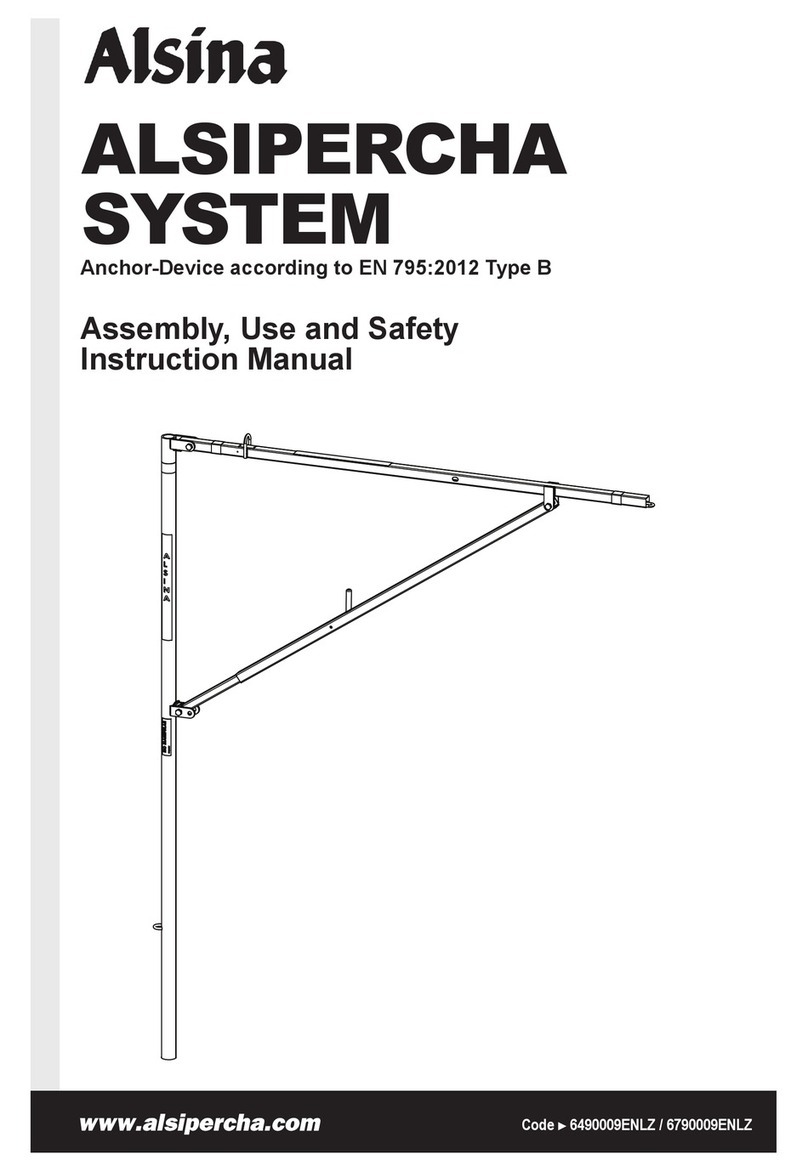
6490009ENLZ / 6790009ENLZ ►2◄
Introduction / Certifi cation Alsipercha System
Apart from the assembly and operating instructions, each chapter
includes a series of safety recommendations. It is important that
these are observed. However, these recommendations are neither
exhaustive nor defi nitive, and should they not coincide with the
indications in the Health and Safety Plan or its equivalent according to
local legislation, the latter shall prevail.
If there are persons who cannot read the documentation or have
diffi culty doing so, they must follow the customer’s instructions and
indications.
Should you have any questions regarding the contents of this manual
or any suggestions as to how it can be improved, please address your
comments to your Alsina Marketing Technician or through our website:
www.alsina.com
Info In order to obtain the best performance from its
formwork systems, Alsina continuously updates the
assembly and operation instructions for its products.
For further information, contact the Alsina Marketing
Technician in your area. The locations of the Alsina Group’s
Sales Network are available at www.alsina.com, or you can
Introduction
Alsina’s instructions for installation, use and safety are intended as
a guide to the procedures required for safe and correct assembly,
disassembly and use of formwork systems under normal conditions, in
line with the standards commonly accepted on work sites. Any specifi c
work circumstance falling outside these standards may require them
to be adapted. When in doubt, do not hesitate to contact one of our
technical departments, anywhere in the world.
The instructions in this document are intended to explain to users
and technicians how the system works; they should ensure correct
preparation and use of the equipment on site. Consequently,
there will be references to general standards that any professional
user should be familiar with. Thus, it is best not to reproduce them in
this manual, since any modifi cations to these standards would lead
to discrepancies between the standards and the manual and could
cause confusion. Users should always refer to the latest version of the
standards in force.
Therefore, the references in this manual in no way annul, replace or
prevail over:
1- Standards and regulations on prevention of risks in the workplace
specifi c to a country or region.
2- The instructions in the specifi c Health and Safety Plan for the works.
3- Safety instructions in the evaluations and plans applying to specifi c
work functions in a company.
4- Technical orders and instructions specifi c to particular stages of
the works, issued by the technical directors, the health and safety
offi cer, the foremen and/or Prevention Resources.
Throughout the project, users shall respect, at all times, the specifi c
laws, standards and regulations of the country or region related to
prevention of risks in the workplace and any other legislation applicable
to each case and, if necessary, supplement the instructions and adapt
to other Work Safety Measures.
It is the customer’s responsibility to prepare, document, implement
and review the risk evaluation for the construction work.
This documentation provides the basis for the evaluation of specifi c
risks in the works, and Alsina’s Instruction Manuals may in no case be
regarded as a substitute.
Sets of vertical formwork equipment, as systems, are made up
by joining different components. As far as possible, drawings and
diagrams have been included as an aid to understanding these
instructions. All personnel working with these products should be
familiar with the contents of this document and the safety instructions
therein.
The illustrations in this manual refer, in part, to different phases of the
assembly process. Customers should ensure that they have a copy of
the assembly and operating instructions, supplied by Alsina, and that
these are known to and available to users on site.




























